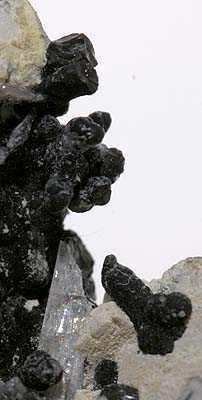Alamosite
| Alamosite | |
|---|---|
|
Transparent crystals of alamosite in the matrix of leadhillite and melanotekite | |
| General | |
| Category | Inosilicates |
| Formula (repeating unit) | Pb12Si12O36 |
| Strunz classification | 09.DO.20 09 |
| Crystal symmetry | Monoclinic – prismatic, H-M symbol (2/m), space group P2/n |
| Unit cell | a = 11.209 Å, b = 7.041 Å, c = 12.22 Å, Z = 12; β = 113.15° |
| Identification | |
| Color | Colorless |
| Cleavage | {010} perfect |
| Mohs scale hardness | 4.5 |
| Luster | Adamantine |
| Streak | White |
| Diaphaneity | Transparent to translucent |
| Specific gravity | 6.49 |
| Optical properties | Biaxial (-) |
| Refractive index | nα = 1.947, nβ = 1.961, nγ = 1.968 |
| Birefringence | δ = 0.021 |
| 2V angle | 65° (meas.) |
| References | [1][2] |
Alamosite (Pb12Si12O36) is a colorless silicate mineral named after the place where it was discovered, Álamos, Sonora, Mexico. It is a rare secondary mineral occurring in the oxidized zones of lead-rich deposits. For example, the infobox picture shows its association with black leadhillite.[1]
References
- ↑ 1.0 1.1 Alamosite. Webmineral. Retrieved on 2011-10-10.
- ↑ Alamosite Mineral Data. Mindat.org. Retrieved on 2011-10-10.
